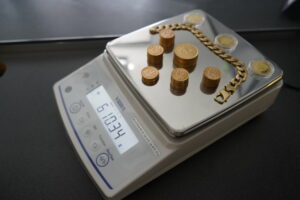What is a hallmark?
Most precious metals that are used for jewellery, cutlery or giftware is an alloy. This gives the jewellery its durability and flexibility. The UK’s regulations state that the precious metals gold, silver, palladium and platinum must all contain a certain percentage of pure metal to qualify as “precious”. This purity level is called the “fineness”.
Due to the value of pure metals it is important that you know the jewellery is authentic. It is impossible to determine from the sight and touch if it is solid silver or gold, or is a base-metal with plating or is a weak metal. There is an enormous opportunity for fraud in the jewellery industry. The hallmarking process is used to protect both jewellery suppliers and buyers by ensuring that items are authentic.
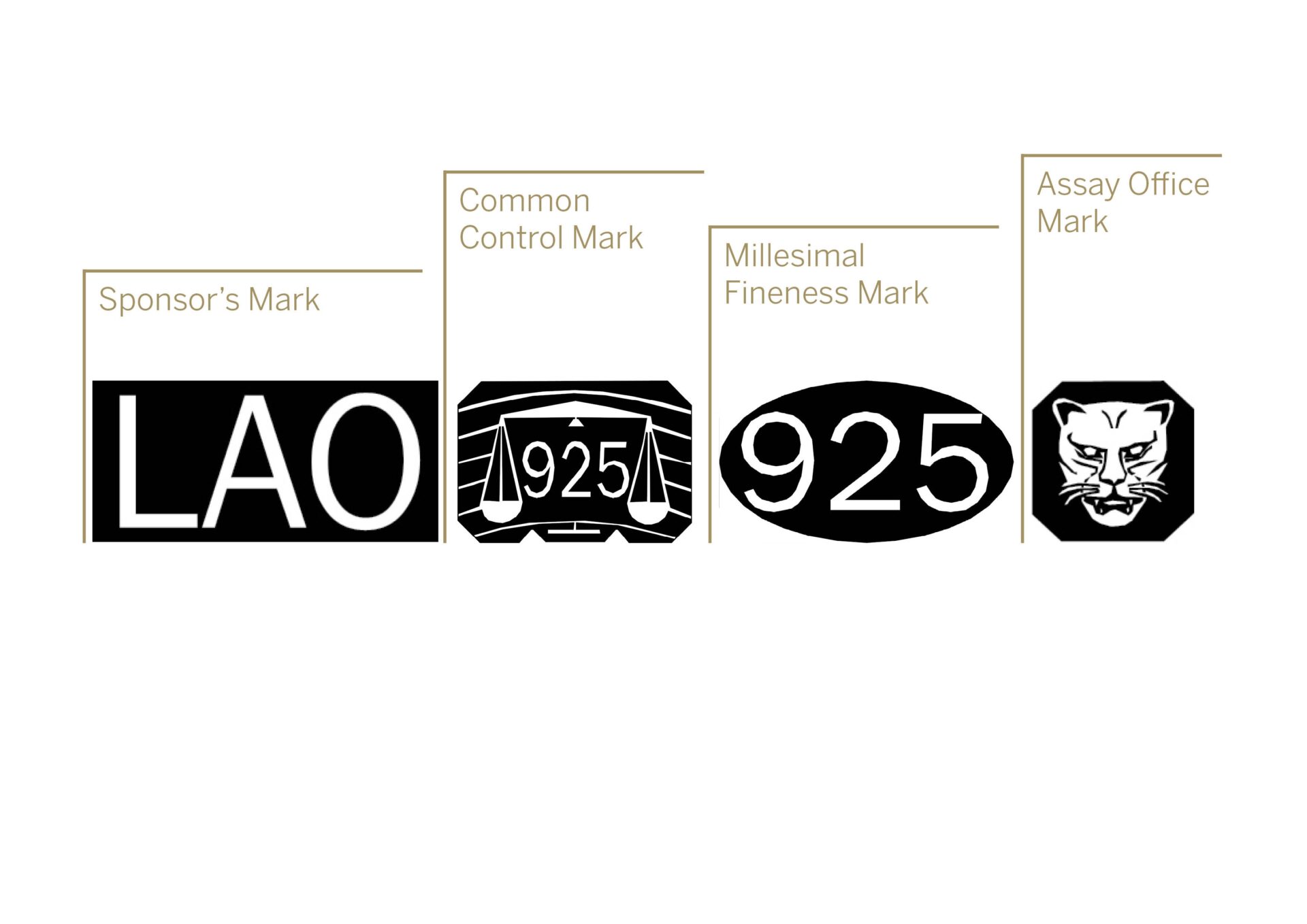
What does a hallmark show?
The assay offices in the UK test and mark each piece of hallmarked jewelry to ensure that they meet the purity standards for their respective metals. Imagine a certificate, but with a stamp. It details information such as the name of the manufacturer, where the metal was tested, and the purity.
The hallmarks will be placed in a line that is less than 1.5mm high. From left to right, the most common order for hallmarks is sponsor (purity), fineness and assay. The addition of other hallmarks is optional. You can add a date letter or commemorative mark, but you’ll most likely only see them if they are being used as a decorative element. In general, however, the hallmark will usually be hidden on jewellery, such as the inner band of the ring or the backside of the pendant, so that it does not disrupt its aesthetics.
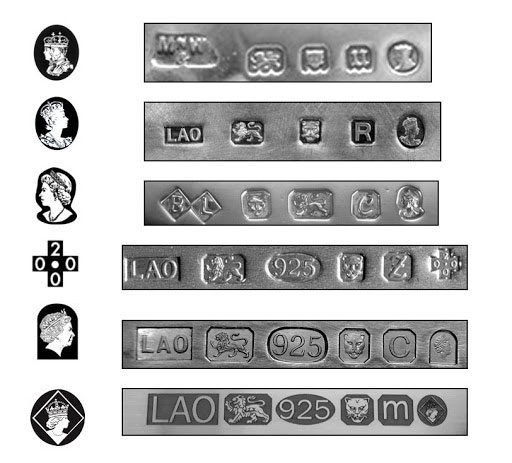
What are the metals that have a hallmark?
To be sold legally as authentic, gold, silver, palladium, and platinum must all undergo testing and marking. Each metal must be marked with a minimum amount of weight.
-
- Platinum 0.5 Grams
- One gram of Gold
- Palladium 1 Gram
- Silver 7.78 Grams
Hallmarks Required by Law
Makers/Sponsors Mark
-
-
- The company registered with this mark is the one that sent the jewelry to be marked.
- Each jeweller has their own distinctive mark that allows you to track a particular piece back to the original source.
- James Porter & Son’s makers mark, as shown on the picture, is ‘JP&S.
-
The millesimal fineness scale
-
-
- The mark indicates the amount of precious metal contained in the item expressed as a percentage.
- The number will be in different shapes for each type of metal.
- This mark indicates the minimum alloy standard found during testing to guarantee that your jewelry will never be less fine than described.
- Current standards are listed below (all describe the parts per 1,000 of pure metal).
- Gold– 9ct 375, 14ct 585, 18ct 750 and 22ct 911
- Sterling silver (925 sterling) and Britannia Silver (958)
- Platinum (950)
- Palladium 500 and 950
-
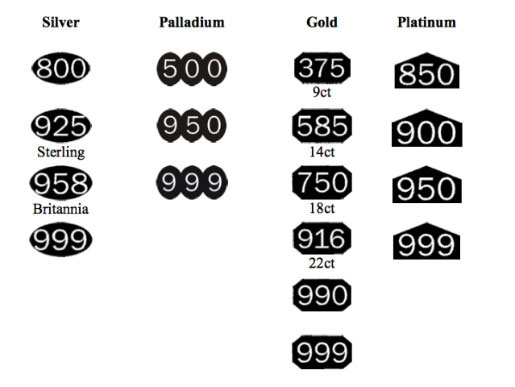
Assay Office Mark
-
-
- In the UK there are four assay offices where all jewellery items must be hallmarked and tested.
- The office symbol allows owners to track their articles back to the original testing locati0n.
- The 4 UK Assay Offices are listed below. Other assay offices no longer exist. If the item is older than 1960, you may find it with an assay mark that’s different.
- Birmingham represented by an anchor
- London is represented by a black leopard
- Sheffield is represented by the Tudor rose
- Edinburgh is represented by the castle
-

Optional Hallmarks
Date letter mark
-
-
- Each year, on January 1, a brand new stamp with a date is issued. At the end of each year, this stamp will be destroyed.
- Since 1999, date letters are no longer required on modern products.
- The font and stamp shape change each year. This allows you to determine when an article was tested.
- The four UK assay offices used different letters to label dates before the Act of 1973 was introduced. Each assay office has used the same lettering since the Act’s introduction.
- The date letters can be seen in the picture to help identify an item of jewellery’s age.
-

The traditional fineness mark
You may see both the fineness marks that are mandatory and the traditional ones. The London Assay Office applies these marks as standard, while they are optional in other places.

Commemorative Marks
Articles commemorating national landmarks will have these hallmarks applied. The use of commemorative marks is optional but can be a good way to determine age, as they are often accompanied by portraits that highlight a specific date.
Convention Mark
The UK is a member of the International Convention of Hallmarks since 1972. It is an international agreement that aims to protect the global trade in jewellery by using internationally recognized ‘control marks.’ These are listed below.
Assay Office marks may differ in shape depending on whether an article is made of gold, palladium, or silver. However, among all the optional hallmarks the “common control” mark is most important.
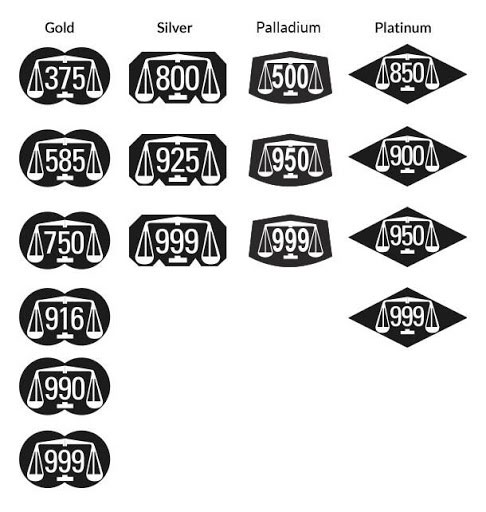
Two Hallmark methods
Stamp and laser are the two most common types of marking. In the past, hallmarking was done by stamping into jewellery. This was not ideal. The item could become slightly misshaped if it was hollow, or delicate. As the metal ages, the stamping can become visible from the outside.
Most manufacturers use lasers to mark their products today. The laser mark is popular because it does not alter the design of intricately crafted jewellery or wedding rings with stone settings.
This is a great way to make rings smaller, but the only downside is that laser marks can easily be removed. This can happen during the sizing procedure. The ring must be taken back to the assay to get its laser hallmark restored.
At Cash for Gold, we can test and determine your gold jewellery and give you the quote instantly. It is totally fine if you dont want to sell your jewellery for now, but still want some quick cash, we provide Gold Loan service as well.

